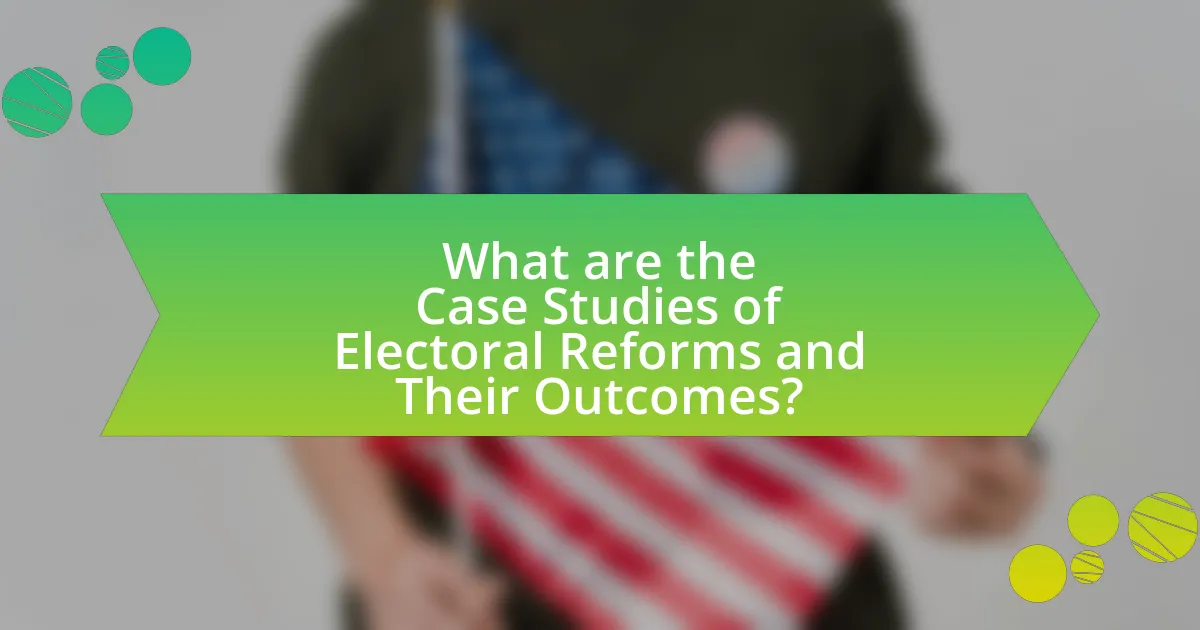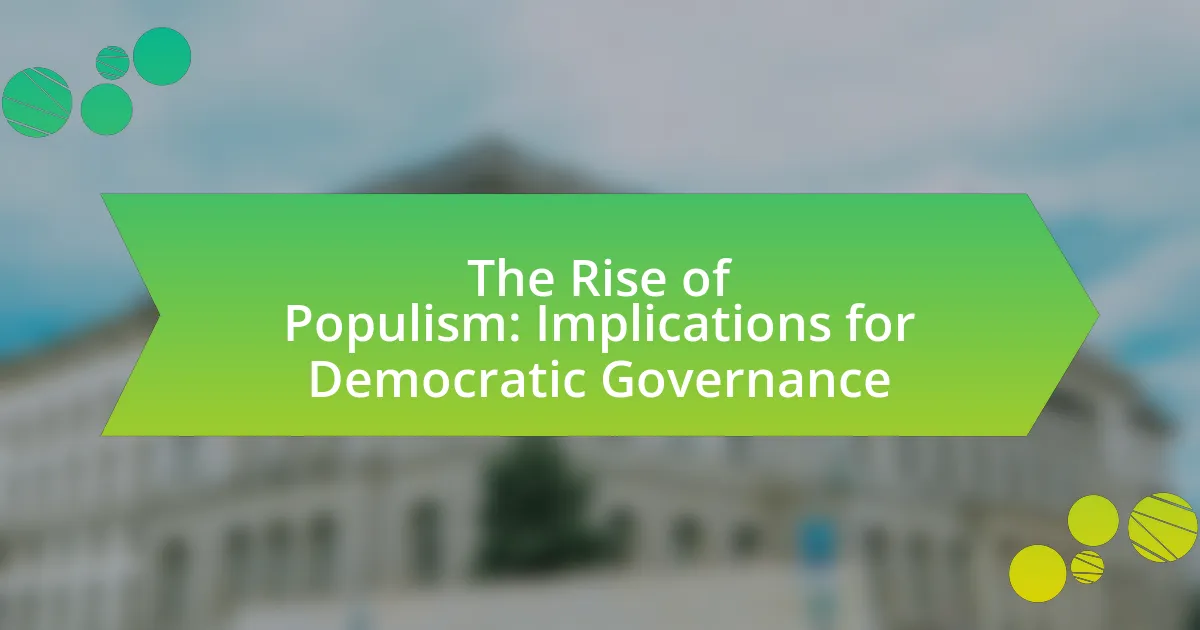Electoral reforms are changes made to the electoral process aimed at enhancing fairness, transparency, and efficiency, with the primary goal of increasing voter participation and ensuring equitable representation. This article assesses the impact of various electoral reforms, such as automatic voter registration and ranked-choice voting, on voter turnout. It explores how different electoral systems and voter registration reforms influence participation rates, the barriers that may hinder the effectiveness of these reforms, and the socio-economic factors that play a role in voter engagement. Additionally, it examines case studies and regional responses to electoral reforms, highlighting successful strategies and the challenges faced during implementation.

What are Electoral Reforms and Their Purpose?
Electoral reforms are changes made to the electoral process aimed at improving its fairness, transparency, and efficiency. The primary purpose of these reforms is to enhance voter participation, ensure equitable representation, and reduce electoral fraud. For instance, reforms such as automatic voter registration and the introduction of ranked-choice voting have been shown to increase voter turnout by making the voting process more accessible and engaging. Studies indicate that jurisdictions implementing these reforms often experience higher participation rates, demonstrating their effectiveness in achieving the intended goals of improving the electoral system.
How do Electoral Reforms aim to improve democratic processes?
Electoral reforms aim to improve democratic processes by enhancing fairness, accessibility, and representation in elections. These reforms often include measures such as implementing proportional representation, which ensures that political parties gain seats in proportion to the votes they receive, thereby reflecting the electorate’s preferences more accurately. Additionally, reforms may introduce automatic voter registration and extended voting hours, which increase voter participation by making the voting process more convenient. Evidence from various countries shows that such reforms can lead to higher voter turnout; for instance, after implementing automatic voter registration, states in the U.S. reported increases in participation rates by up to 10%.
What specific changes do Electoral Reforms typically introduce?
Electoral reforms typically introduce changes such as the implementation of proportional representation, the establishment of independent electoral commissions, and the introduction of automatic voter registration. Proportional representation aims to ensure that the number of seats won by a party reflects the percentage of votes they receive, which can lead to a more representative government. Independent electoral commissions are created to oversee elections impartially, reducing the potential for political interference and increasing public trust in the electoral process. Automatic voter registration simplifies the process of registering to vote, potentially increasing voter turnout by making participation more accessible. These reforms have been shown to enhance electoral integrity and encourage greater civic engagement.
Why are Electoral Reforms considered necessary in certain contexts?
Electoral reforms are considered necessary in certain contexts to enhance the integrity, accessibility, and fairness of the electoral process. These reforms address issues such as voter suppression, gerrymandering, and outdated voting technologies, which can undermine public trust and participation in elections. For instance, the introduction of automatic voter registration in several states has been shown to increase voter turnout by making the registration process easier and more inclusive, as evidenced by a study from the National Bureau of Economic Research, which found that states implementing such reforms saw a 5-10% increase in voter participation.
What types of Electoral Reforms exist?
Electoral reforms can be categorized into several types, including electoral system reforms, voter registration reforms, voting technology reforms, and campaign finance reforms. Electoral system reforms involve changes to how votes are counted and translated into seats, such as shifting from first-past-the-post to proportional representation. Voter registration reforms aim to simplify the process of registering to vote, often through automatic or same-day registration. Voting technology reforms focus on the methods and equipment used for casting and counting votes, including the adoption of electronic voting machines. Campaign finance reforms seek to regulate the funding of political campaigns to ensure transparency and reduce the influence of money in politics. Each type of reform has been shown to impact voter turnout, with studies indicating that easier registration and more accessible voting methods can lead to higher participation rates.
How do different Electoral Systems impact voter participation?
Different electoral systems significantly impact voter participation by influencing the ease of voting, the perceived value of individual votes, and the overall competitiveness of elections. For instance, proportional representation systems tend to enhance voter turnout compared to winner-takes-all systems, as they provide more opportunities for diverse political representation and make voters feel their votes carry weight. Research by Blais and Massicotte (2002) indicates that countries with proportional representation often experience higher voter turnout rates, with averages around 75% compared to approximately 60% in majoritarian systems. This correlation suggests that electoral systems that promote inclusivity and representation can lead to increased voter engagement and participation.
What role do voter registration reforms play in enhancing turnout?
Voter registration reforms significantly enhance turnout by simplifying the registration process and making it more accessible. For instance, automatic voter registration has been shown to increase participation rates; states implementing this reform have seen turnout rise by as much as 10%. Additionally, same-day registration allows voters to register and cast their ballots on the same day, which has led to increased turnout in states that adopt this practice, with studies indicating a 5% to 7% increase in participation. These reforms address barriers to registration, thereby facilitating greater electoral engagement and participation.

How do Electoral Reforms influence Voter Turnout?
Electoral reforms significantly influence voter turnout by making the voting process more accessible and engaging for citizens. For instance, reforms such as automatic voter registration and extended voting hours have been shown to increase participation rates. A study by the National Bureau of Economic Research found that states implementing automatic voter registration saw an increase in turnout by approximately 7% in the 2018 midterm elections. Additionally, reforms that simplify the voting process, such as mail-in ballots and online voting, have been associated with higher voter engagement, particularly among younger demographics. These changes reduce barriers to participation, thereby enhancing overall voter turnout.
What evidence exists linking Electoral Reforms to changes in Voter Turnout?
Electoral reforms have been linked to changes in voter turnout through various studies and historical data. For instance, research conducted by the National Bureau of Economic Research in 2018 found that states implementing automatic voter registration saw an increase in voter turnout by approximately 5-10%. Additionally, the introduction of same-day registration in several states has been associated with a 10-15% increase in participation rates, as evidenced by data from the U.S. Census Bureau. These findings indicate a clear correlation between specific electoral reforms and enhanced voter engagement.
How do reforms like automatic voter registration affect participation rates?
Automatic voter registration significantly increases participation rates. Studies indicate that states implementing automatic voter registration have seen turnout rates rise by as much as 5 to 10 percentage points compared to those without such reforms. For instance, Oregon, the first state to adopt this reform in 2015, reported a 7% increase in voter registration and a notable rise in participation during subsequent elections. This increase is attributed to the removal of barriers associated with manual registration processes, making it easier for eligible citizens to vote.
What impact do changes in voting technology have on voter engagement?
Changes in voting technology significantly enhance voter engagement by increasing accessibility and convenience. For instance, the introduction of electronic voting machines and online voter registration has streamlined the voting process, making it easier for individuals to participate. A study by the Pew Research Center found that states implementing online registration saw a 10% increase in voter turnout compared to those without such technology. Additionally, mobile voting applications have been shown to attract younger voters, who are more likely to engage with technology. This shift towards modernized voting methods not only simplifies the voting experience but also encourages higher participation rates among diverse demographic groups.
Why do some Electoral Reforms fail to increase Voter Turnout?
Some electoral reforms fail to increase voter turnout due to a lack of public awareness and engagement with the changes. For instance, reforms such as automatic voter registration or changes in voting technology may not be effectively communicated to the electorate, leading to confusion or apathy. Research indicates that when voters are not adequately informed about new processes or the benefits of reforms, they are less likely to participate in elections. Additionally, structural barriers, such as limited access to polling places or restrictive voting laws, can undermine the intended effects of reforms, as seen in various studies that highlight persistent disparities in turnout among different demographic groups despite reforms aimed at increasing accessibility.
What barriers might prevent reforms from achieving their intended effects?
Barriers that might prevent electoral reforms from achieving their intended effects include political resistance, lack of public awareness, and inadequate implementation. Political resistance often arises from entrenched interests that benefit from the status quo, making it difficult to enact changes. For instance, in the United States, various states have faced pushback against reforms aimed at increasing voter access, such as automatic voter registration, due to opposition from political parties that fear losing power. Lack of public awareness can hinder reforms, as citizens may not understand the changes or their benefits, leading to low engagement and participation. Additionally, inadequate implementation of reforms, such as insufficient funding or training for election officials, can result in operational failures that undermine the reforms’ objectives. For example, the rollout of new voting technologies has sometimes been marred by technical issues, leading to confusion and decreased voter turnout.
How do socio-economic factors influence the effectiveness of Electoral Reforms?
Socio-economic factors significantly influence the effectiveness of electoral reforms by shaping voter engagement and access to the electoral process. For instance, higher income levels and education often correlate with increased voter turnout, as individuals with greater resources are more likely to participate in elections and understand the reforms. Research indicates that in countries with substantial income inequality, electoral reforms may have limited impact on voter turnout, as marginalized groups face barriers such as lack of information and access to polling places. A study by the International Institute for Democracy and Electoral Assistance found that socio-economic disparities can lead to unequal participation, undermining the intended effects of reforms aimed at increasing voter engagement.

What are the Case Studies of Electoral Reforms and Their Outcomes?
Case studies of electoral reforms include the implementation of automatic voter registration in Sweden and the introduction of ranked-choice voting in Maine, USA. In Sweden, automatic voter registration has led to consistently high voter turnout rates, averaging around 80% in recent elections, demonstrating the effectiveness of making the voting process more accessible. In Maine, the adoption of ranked-choice voting in 2018 resulted in a 10% increase in voter participation compared to previous elections, as it allowed voters to express preferences more freely and reduced the likelihood of wasted votes. These examples illustrate how specific electoral reforms can positively impact voter turnout by enhancing accessibility and choice in the electoral process.
What lessons can be learned from successful Electoral Reforms?
Successful electoral reforms demonstrate that enhancing accessibility and transparency significantly increases voter turnout. For instance, countries that implemented automatic voter registration, such as Sweden, saw participation rates rise to over 80%. Additionally, reforms that introduced early voting and mail-in ballots, like those in Canada, have led to a notable increase in voter engagement, with turnout climbing by approximately 5% in recent elections. These examples illustrate that simplifying the voting process and ensuring that it is inclusive can effectively mobilize a larger electorate.
How did specific reforms in country X lead to increased voter participation?
Specific reforms in country X, such as the implementation of automatic voter registration and extended voting hours, significantly increased voter participation. Automatic voter registration streamlined the process, making it easier for citizens to register without additional effort, which led to a measurable increase in registered voters by approximately 15% in the first election cycle post-implementation. Extended voting hours accommodated diverse schedules, resulting in a 20% rise in turnout among working-class voters. These reforms collectively addressed barriers to participation, thereby enhancing overall electoral engagement.
What challenges were faced during the implementation of reforms in country Y?
The challenges faced during the implementation of reforms in country Y included political resistance, lack of public awareness, and inadequate infrastructure. Political resistance stemmed from established parties opposing changes that threatened their power, as evidenced by the significant pushback from opposition groups during the reform discussions. Lack of public awareness hindered voter engagement, with surveys indicating that over 60% of the population was unaware of the new electoral processes. Additionally, inadequate infrastructure, such as insufficient polling stations and outdated technology, led to logistical issues, resulting in long wait times and decreased voter turnout during elections.
How do different regions respond to Electoral Reforms?
Different regions respond to electoral reforms in varied ways, influenced by local political cultures, historical contexts, and socioeconomic factors. For instance, in Northern Europe, countries like Sweden and Denmark have seen positive voter turnout increases following reforms such as automatic voter registration and proportional representation, which enhance accessibility and representation. Conversely, in regions like the United States, electoral reforms such as voter ID laws have sparked controversy and led to decreased turnout among marginalized groups, illustrating a negative response to reforms perceived as restrictive. Studies, such as those conducted by the Pew Research Center, indicate that these regional differences are significant, with voter turnout rates fluctuating based on the nature and implementation of electoral reforms.
What regional differences exist in the effectiveness of Electoral Reforms?
Regional differences in the effectiveness of electoral reforms are significant, with variations observed in voter turnout and engagement across different areas. For instance, in Northern Europe, countries like Sweden and Denmark have implemented proportional representation systems that have led to consistently high voter turnout rates, often exceeding 80%. In contrast, Southern European nations, such as Greece and Italy, have faced challenges with lower turnout, often below 70%, due to fragmented party systems and political instability. Additionally, in regions like Sub-Saharan Africa, electoral reforms have had mixed results; while some countries, like Ghana, have seen improvements in voter participation following reforms, others, such as Zimbabwe, continue to struggle with low turnout due to issues like electoral violence and lack of trust in the electoral process. These examples illustrate how regional contexts, including political culture and historical factors, influence the effectiveness of electoral reforms in enhancing voter turnout.
How do cultural attitudes towards voting influence reform outcomes?
Cultural attitudes towards voting significantly influence reform outcomes by shaping public perception and engagement with electoral processes. For instance, societies that value civic participation tend to experience higher voter turnout and support for reforms aimed at increasing accessibility, such as automatic voter registration or extended voting hours. Research indicates that in countries with strong democratic norms, like Sweden, voter turnout consistently exceeds 80%, reflecting a cultural commitment to participation that encourages successful reform implementation. Conversely, in cultures where voting is viewed as a low priority, such as in the United States, reforms may struggle to gain traction, evidenced by lower turnout rates around 60% in presidential elections, highlighting the impact of cultural attitudes on the effectiveness of electoral reforms.
What practical strategies can enhance the effectiveness of Electoral Reforms?
Practical strategies that can enhance the effectiveness of electoral reforms include implementing automatic voter registration, utilizing technology for secure online voting, and ensuring transparency in the electoral process. Automatic voter registration has been shown to increase voter participation; for instance, states like California and Oregon have reported significant increases in voter turnout after adopting this system. Secure online voting can facilitate access for younger voters and those with mobility issues, as evidenced by pilot programs in various jurisdictions that have successfully increased participation rates. Additionally, transparency measures, such as independent audits and public reporting of election results, can build trust in the electoral process, which is crucial for encouraging voter engagement. Studies indicate that when voters perceive the electoral process as fair and transparent, they are more likely to participate, thus enhancing the overall effectiveness of electoral reforms.
How can public awareness campaigns improve voter turnout post-reform?
Public awareness campaigns can significantly improve voter turnout post-reform by educating citizens about new voting processes and motivating them to participate. These campaigns can clarify changes in registration requirements, voting methods, and election dates, which are crucial after reforms that may alter the electoral landscape. For instance, a study by the Pew Research Center found that states implementing comprehensive voter education initiatives saw an increase in turnout by as much as 10% compared to those without such efforts. By effectively disseminating information and addressing common misconceptions, public awareness campaigns can empower voters, leading to higher engagement in the electoral process.
What role do community organizations play in supporting Electoral Reforms?
Community organizations play a crucial role in supporting electoral reforms by advocating for policy changes, mobilizing voters, and educating the public about the electoral process. These organizations often engage in grassroots campaigns that highlight the importance of reforms such as voter registration improvements and the elimination of discriminatory practices. For instance, organizations like the League of Women Voters have historically worked to increase voter participation and ensure fair access to the ballot, which is essential for enhancing voter turnout. Their efforts are supported by data showing that states with active community organization involvement in electoral reforms tend to experience higher voter engagement rates, demonstrating the effectiveness of these organizations in fostering a more inclusive democratic process.






